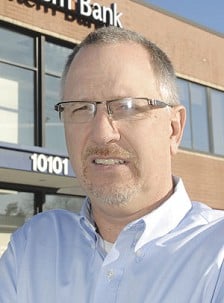Ag lending: A position of strength
Banks compete for share of growing farm loan market

Farm lending conditions are expected to continue improving in Iowa and across the country this year. About two-thirds of U.S. farm operations were in favorable financial condition early last year, and a decrease in debt combined with income growth is expected to give farmers one of the largest financial cushions in four decades. Bankers say they’re being conservative in their farmland lending, despite record-low interest rates and historically high land prices.
Soaring farmland prices are making some people wonder if agriculture finance is riding a bubble similar to that of the 1980s. However, farm banking experts say an ag-land bust is not likely.
“People are saying, ‘What prevents us from repeating the ’80s?’” said Tom Ricke, market president for Great Western Bank’s Agribusiness Group. It’s unlikely that history will repeat itself, Ricke said, because farmers are carrying much less debt and bankers are lending more conservatively.
Though his mandate is to expand Great Western’s ag-lending footprint in Iowa and neighboring states, Ricke and his colleagues aren’t lending to every farmer who walks through the door.
“It boils down to: it’s got to make sense,” Ricke said. “I know some huge operations that don’t have financing for next year, and they won’t get financing. The majority of producers are doing extremely well, but you will always have operations that fail.”
Ricke worked in farm lending with Wells Fargo & Co. for 23 years prior to joining Great Western in 2008. That year, National Australia Bank, the dominant agriculture lender in Australia, acquired Great Western and set out to make it one of the top farm lenders in the United States. Since then, the Watertown, S.D.-based bank has bulked up its agricultural loan portfolio to $936 million at the end of 2010, leapfrogging from the 40th-largest to eighth-largest U.S. farm lender by loan volume in less than three years.
‘Pretty darn good’
Great Western is among a wide range of financial institutions, from rural community banks to regional players on up to the largest banks, that are seeking growth in the agricultural lending niche. Banks with at least 14 percent of their loans in agriculture are considered farm banks, and nationwide there are more than 2,100 financial institutions in that niche. Combined, farm banks account for just over half the $243 billion in outstanding agricultural loans in the United States, with the remainder of lending through Farm Credit Services of America, which is part of the Farm Credit System, a nationwide cooperative lending network.
“Our agricultural economy has been pretty darn good in the past few years,” said Don Foley, agricultural vice president of the Iowa Bankers Association and Iowa Bankers Mortgage Corp. “Overall, there has been pretty good weather for getting the crops in and out on time. Farmers have made good amounts of money, especially if they haven’t owed a whole lot on their land.”
High farm incomes are part of the story behind record-high farmland prices. According to an Iowa State University survey conducted in November, the average farmland value in Iowa reached $6,708 per acre, a 32.5 percent increase from 2010. Some of the contributing factors cited by ISU economist Michael Duffy for the sharp increase were low interest rates and the dismal performance of the stock market, which made land more attractive to hold.
Kevin Ross, a Pottawattamie County farmer who grows corn and soybeans and raises calves on 550 acres near Council Bluffs, said the biggest reaction to high land prices by lenders recently has been much higher down payment requirements for farmland loans. “You’ll see a lot of 50 percent down payments; it used to be that they’d require 30 percent or sometimes less,” he said.
Ross, who currently serves as president of the Iowa Corn Growers Association, said he feels there isn’t a lot of enthusiasm lately among farmers to purchase land. “You’ll still see land change hands, but at these prices, the majority of the people I talk to see this as a land bubble,” he said. “It’s especially hard for young farmers, because purchasing a piece of ground is such a huge outlay.”
As for competition among lenders, Ross said he has received more solicitations for business from banks than in the past, yet “it’s not quite as easy to walk into your local bank anymore to get a loan.” Ross said he currently has loans with Farm Credit Services, a small local bank and a larger bank. “I haven’t had a bad experience, but I do know it’s tougher for them,” he said. “You know that as a farmer you need to keep these local banks healthy; that’s certainly on your mind.”
Nationwide, about 65 percent of farms were in a favorable financial position entering 2011, meaning they had both positive income and relatively low farm debt, according to the 2011 Agricultural Income and Finance Outlook, the latest available report prepared by the Economic Research Service (ERS) of the U.S. Department of Agriculture (USDA). During the farm crisis in 1986, 48 percent of farms were in a favorable position.
At the start of 2011, 2 percent of U.S. farms were in a vulnerable financial position, defined by the USDA as having a negative net cash income and a debt-to-asset ratio of 0.4 or greater. Another 29 percent of farms were in a marginal position, with negative net cash income but a debt-to-asset ratio below 0.4.
A projected decrease in farm debt, combined with an increase in farm income and low interest rates, is expected to result in a debt repayment capacity utilization (DRCU) ratio of about 38 percent, the lowest ratio since the early 1970s, according to the ERS outlook, which was released in December. The DRCU, a ratio measuring actual farm debt outstanding relative to the maximum feasible farm debt, stood at 59 percent in 2009.
“As farmers do not necessarily use all of their debt repayment capacity, the DRCU is a measure of the extra cushion the farm sector has to repay farm debt over time solely through the production and sale of farm products and services,” according to the report.
Profitable operations
Regardless of their lending capacity, most banks in Iowa appear to have a fixed amount in mind that they’re willing to lend for land purchases, generally about $3,000 to $5,000 per acre, said William Edwards, an ISU Extension Service economist. “So I think they’re being pretty conservative and are expecting people to put down a considerable down payment.” In other instances, Edwards said, farmers are pledging land that’s already paid for as collateral to increase the amount that they can borrow. “We also have people who have quite a bit of cash to put into land,” he said.
In October, the Federal Reserve issued a supervisory letter to banks cautioning them to more closely evaluate farm loans, citing volatility in commodity prices, farmland values and production costs.
“There is caution from regulators because land values have gone up so high, so fast,” Foley said. “They want farmers to be good marketers and to be aware of pitfalls that could come down the road. I think regulators are apprehensive about where things are now. Those who have been in banking since the ’70s and ’80s know how things can go the other way. They want bankers to use good judgment, to analyze things properly and to use good judgment so they aren’t blindsided as they move forward.”
David Mackaman, Des Moines market president and Western Iowa business banking manager for Wells Fargo Bank Iowa, said, “The healthy ag economy over the past two to three years has clearly created increased loan demand relative to the opportunities we have seen in other areas of the economy.”
Wells Fargo is the top agricultural lender in the country, with an agricultural loan portfolio of nearly $8.4 billion as of the end of the third quarter of 2011, the most recent data available.
“Ag lending is definitely an area of growth for our company, and that’s certainly true in Iowa,” Mackaman said. “Both row crop and livestock producers are generating strong cash profits. The cash inflows have generally decreased the demand for farm operating loans, but our customers are continuing to have credit needs to finance new equipment, facility upgrades and land acquisition. Cash rents have increased, as have land prices, which have also created increased loan demand.”
In evaluating loan requests, Wells Fargo performs stress tests of repayment capacity based on five-year averages for land rents, commodity prices and higher interest rates, he said.
“We want to be comfortable that our clients can handle the debt they are taking on under a wide range of economic conditions, which might be different and less favorable than what we are currently experiencing,” he said.
Ricke said Great Western Bank is using the resources of its parent, National Australia Bank, to offer specialized products to its clients, such as access to derivatives products through a trading desk in New York, and in smaller denominations to make that risk-management tool available to smaller producers.
He said his bank is also winning more business because it’s taking the lead position whenever possible on loans, which means farmers don’t have to “repeat their story” to several different bankers. “Our goal is more products per customer,” he said. “We’re trying to be their one-stop shop.”
Though increased competition has reduced banks’ profit margins on agricultural loans overall, there is more opportunity in ag lending than there has ever been, Ricke said.
“We don’t want it all,” he said. “We just want our share of it.”
Click here to see Top U.S. agricultural lenders – 2010











